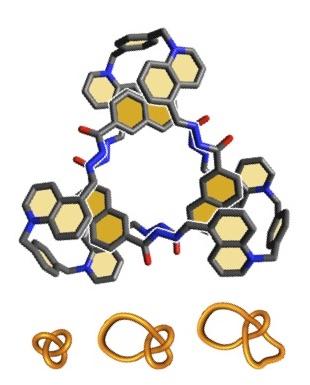UNIGE researchers have succeeded in tying molecules together, thereby modifying their intrinsic mechanical properties

Credit: © UNIGE
Knots are all around us: in computer cables, headphones and wires. But, although they can be a nuisance, they’re also very useful when it comes to tying up your laces or when you go sailing. In maths, there are no less than six billion different potential knots, but what about knots in chemistry? Since the 1970s, scientists have been trying to knot molecules together to create new, custom-made mechanical properties, which will give rise to new materials. The first successes took place twenty years later but the process remains laborious. Today, researchers from the University of Geneva (UNIGE), Switzerland, have developed a simple and effective technique for tying knots in molecules, and have for the first time observed the changes in properties that result from these interlockings. The results, which you can read about in the journal Chemistry – A European Journal, open up new perspectives for designing materials and transferring information molecularly.
Knots are certainly useful. But what about in chemistry? Is it possible to tie molecules together? The idea first made an appearance in 1971 with the aim of creating new materials induced by the changes in mechanical and physical properties that would result from these interlockings. But it was not until 1989 that Jean-Pierre Sauvage, the French 2016 Nobel Prize winner in chemistry, succeeded. Scientists have subsequently worked hard at trying to form knots but it remains challenging: “To tie molecules together, you have to use metals that attach to the molecules and direct them on a very specific path forming the intersections that are needed to make knots”, explains Fabien Cougnon, a researcher in the Organic Chemistry Department in UNIGE’s Faculty of Sciences. “But it is a complex process that often results in a loss of raw material of over 90%! The resulting amount of molecular knots is typically only a few milligrams at most, not enough to make new materials.”
Hydrophobic molecules that tie together on their own
The UNIGE chemists developed a new technique that makes it possible to create interlocked molecules easily. “We use fatty molecules that we soak in water heated to 70 degrees. Since they are hydrophobic, they try to escape the water at all costs, gathering together and forming a knot by means of self-assembly”, says Tatu Kumpulainen, a researcher in the Physical Chemistry Department in UNIGE’s Faculty of Sciences.
Thanks to this new technique, the Geneva-based chemists can make molecular knots effortlessly, and – even more importantly – without losing any material. “We transform up to 90% of the basic reagents into knots, which means we can consider a real analysis of the changes in the mechanical properties induced by the knots, which has never been done before!” notes Cougnon. Although they cannot choose how the molecules are knotted together, they are able to reproduce the same knot at will, because the same chemical structure will always form an identical knot in aqueous environment.
Each knot has its own mechanical properties
Now that knotting molecules has become easy, what can we do with these knots? Is there any value in forming them? To check the impact of the interlockings, the Geneva chemists chose a family of molecules that all have the same design: they absorb ultraviolet, are fluorescent and are highly sensitive to the general environment, especially the presence of water. “We created four knots, from the simplest to the most complex (0, 2, 3 and 4 intersections), which we compared to a reference molecule which constitutes their basis,» explains Cougnon. “To do this, we first used nuclear magnetic resonance (NMR) to observe the stiffness of the different parts of the knots and the speed and way they move relative to one another.” The scientists found a first change in mechanical properties: the more complex the knots are, the less they move.
The chemists subsequently used spectroscopy to compare the spectra of the four knots with each other. “We soon noticed that the looser single knots (0 and 2 intersections) behaved in the same way as the reference molecule”, continues Kumpulainen. “But when the knots are more complex, the molecules – which were tighter – changed their physical properties and colour! Their way of absorbing and emitting light differed from the reference molecule.” This change in colour means that the scientists can visualise the mechanical properties specific to each assembly, whether it is its elasticity, structure, movement or position.
For the first time, the Geneva chemists have shown that knotted molecules change mechanical properties. “We now want to be able to control these changes from A to Z so that we can use these knots, for example, as indicators for the properties of the environment”, says Kumpulainen. They also plan to build new materials, such as elastics, using the networks of knots now that there is no loss of material when making the intersections. “At last, we can consider transferring information inside a knot thanks to a simple change of position on a part of the knot which would be reflected throughout the structure and would convey the information”, concludes Cougnon.
###
Media Contact
Fabien Cougnon
[email protected]
41-223-796-533
Related Journal Article
http://dx.




